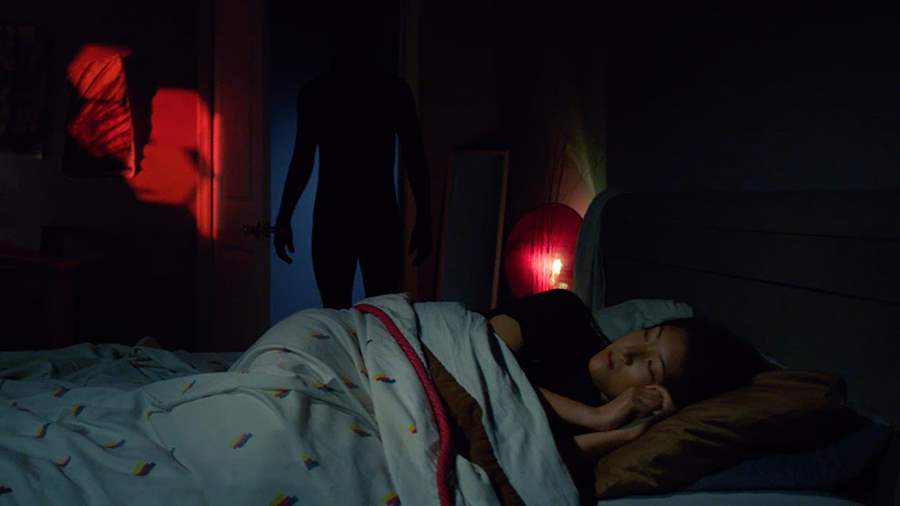Unless you live under a particularly large rock, you’ve probably heard of a little documentary called The Nightmare, allegedly the scariest documentary of the year. You might have heard that The Nightmare is scarier than most horror movies, that it’ll give you nightmares, that it’s disturbing and powerful to the extreme. No movie is ever going to live up to that kind of hype, especially not a low-key documentary about sleep paralysis. But, even putting such high praise aside, The Nightmare is still a bit of a snooze. Our managing editor Tyler Doupe’ reviewed the film months ago and came to a very similar conclusion. You can see his review here.
Courtesy of Rodney Ascher, the filmmaker behind the uneven Shining documentary, Room 237, The Nightmare follows eight subjects over the course of its zippy, 91-minute run-time, all of whom are struggling with sleep paralysis. Ascher switches between to-camera interviews, where his lens hovers intently–or, rather cleverly, peeks from a separate room–as each person takes his or her turn recounting their troubles, and spooky recreations with unnecessarily high production values, where it swoops around like he’s Michael Bay.
That’s pretty much all there is to it. Although it boasts a gnarly poster (a shot of a pillow emblazoned with the words “welcome to the scariest place on earth”) and is packing a significant amount of festival buzz, The Nightmare doesn’t really have a whole lot to say for itself. Those who regularly deal with sleep paralysis may find it comforting to hear similar stories from fellow sufferers, while, for those of us lucky enough to avoid such issues, it’s interesting the first time we hear it described to us. Not so much the eighth time. And that’s where the problems begin.
The main issue with the doc is that there are just too many people involved, all of whom are recounting what is basically the same experience. Over and over and over. There are some interesting personalities thrown into the mix; Forrest is a particular delight, providing the movie’s only real comedic touches, while Chris is a lively participant, although his obsession with understanding his condition is a bit disconcerting. Ascher himself, apparently, had bouts of paralysis but he doesn’t take centre-stage to discuss, which feels like a missed opportunity.
The reconstructions start off super creepy but soon grow tiresome (excuse the pun), particularly after an ill-advised fourth wall break. The problem is, although the “demons” look cool, and are definitely scary, after they’ve shown up a few times we’re pretty much used to them. They also don’t have any real powers, because they’re, presumably, just figments of the sufferer’s imagination. So, unlike a horror movie villain, there’s no real threat there.
Speaking of horror movies, The Nightmare‘s other great failing is in its almost complete lack of attention to the way many films have taken inspiration from sleep paralysis. Movies like A Nightmare On Elm Street, for example, a poster for which featured a shadowy Krueger not unlike the shadowy demons that sufferers see in their dreams. Or Insidious, which also featured a shadowy apparition and even nodded directly to the condition at certain times, particularly in the first installment.
These narrative threads, which are of particular interest to horror fans, are picked up and then dropped with no further discussion, in favour of yet more interviews and reconstructions. It would all be incredibly interesting if we actually learned anything about sleep paralysis but, beyond the fact it can apparently adapt to each person, there’s nothing new gleaned here. If you’re particularly fascinated by the condition, prepare to be disappointed.
Considering it’s basically the same story being told over and over again, The Nightmare is very cannily edited. Ascher doesn’t linger too long on any one person and, if he were to have focused on perhaps four subjects instead of eight, the thing might have felt slightly more cohesive as a result. However, he makes the huge, glaring error of not including any medical personnel, meaning no scientific explanation is offered at any stage. We literally have the word of the subjects and that’s all.
And, when they make any kind of allusions to seeking medical, or psychiatric, treatment it is met with disdain and disbelief. One subject, who was advised to alter his diet and take up exercise, to alleviate his sleep paralysis, scoffs at the idea as though it isn’t a viable, natural treatment for other mental health conditions such as depression. It’s almost as though these people, whether knowingly or not, would prefer to think of the condition as something supernatural.
This idea is perpetuated by Ascher, who structures his film as though he believes it to be the next, great paranormal chiller. It’s nothing new, of course, the same thing was attempted with the underrated, yet similarly pointless, Cropsey and even with more mainstream fare such as Capturing The Friedmans, but at least those documentaries had interesting stories to tell. The Nightmare only really has one angle, recounted by eight different, and not particularly noteworthy, people.
The Nightmare is momentarily diverting, and there are some interesting insights, and even some cool visuals to enjoy, particularly in the beginning. But it feels over-long, it doesn’t have much to say in spite of the admittedly interesting subject matter, and it’s unlikely non-horror fans are going to find it particularly scary. Catch it on Netflix when you can, but don’t go out of your way to see it unless you’re really curious.
WICKED RATING: 4/10
Director(s): Rodney Ascher
Writer(s): N/A
Stars: Siefried Peters, Stephen Michael Joseph, Yatoya Toy, Nicole Bosworth
Year: 2015
Studio/ Production Co: Zipper Bros Films
Language: English
Length: 91 minutes
Sub-Genre: Documentary







